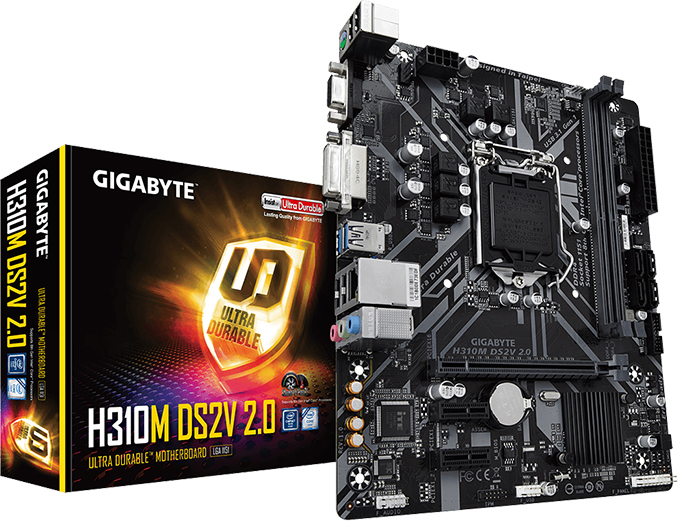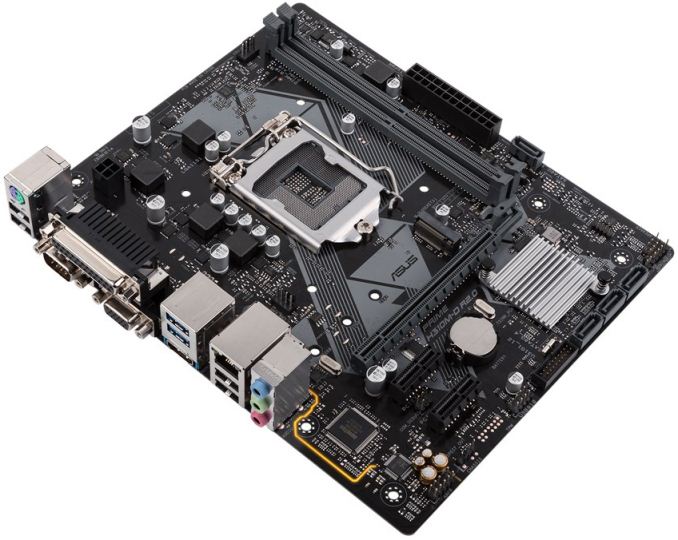Intel Preps New H310 Chipset Revision With Windows 7 Support For Coffee Lake
by Anton Shilov on August 9, 2018 10:00 AM EST
Based on some recent hardware releases from motherboard vendors, it would appear that Intel is prepping a new chipset and appropriate drivers to enable Coffee Lake processors to work with Microsoft’s nine-year-old Windows 7 OS.
Microsoft limited support for the latest CPUs on Windows 7 back in 2016, which is why AMD’s Ryzen as well as Intel’s Kaby Lake, Coffee Lake, and some other chips cannot work with this OS. Meanwhile, Windows 7 defiantly remains a commonly-used operating system both among businesses and individuals who cannot, or do not want to, jump to Windows 10. In a bid to satisfy demand from such users, it would appear that Intel is prepping a special version of its H310 PCH that will enable operation of its latest Coffee Lake processors on Windows 7. ASUS and GIGABYTE already list appropriate motherboards on their websites, but there are a number of catches.
The new chipset is expected to be branded as the H310C or the H310 R2.0, according to a media report and information from makers of mainboards. The PCH allegedly has a new device ID, but is supposedly pin-to-pin compatible with the original H310, though this fact could not be verified at press time. The chipset will ship with Windows 7 x32/x64 drivers for Intel Management Engine Interface, Intel Rapid Storage Technology (SATA), and Intel USB 3.0 drivers. Meanwhile, motherboard makers will have to outfit their products with appropriate Windows 7-compatible drivers for audio and GbE chips they use. Unfortunately, Intel does not seem to plan releasing Windows 7 drivers for its latest iGPUs, so PCs running Intel's Coffee Lake on the H310C (H310 R2.0) and Windows 7 will have to use a discrete graphics card instead. This will naturally make systems running the long-standing OS a bit more expensive than modern PCs with iGPUs.
Intel’s H310 is the company’s entry-level chipset for Coffee Lake processors, so it does not support PCIe 3.0 lanes, USB 3.1 Gen 2, Intel Optane Memory caching SSDs (not that these are supported under Windows 7 anyway), and so on. Evidently, these limitations are important for performance-minded users, so the H310C (H310 R2.0) is not going to appeal to enthusiasts who would like to keep using Windows 7 for some reason. In the meantime, special-purpose systems that need the OS (yet can take advantage of new CPUs) will adopt the platform wholeheartedly despite costs and limitations.
Makers of motherboards already list their ‘Intel H310 R2.0’ badged products on their websites. ASUS has four of them, GIGABYTE also has four SKUs, Colorful is reportedly prepping two models, but does not list them just now. Both ASUS and GIGABYTE offer Windows 7 drivers with their H310 R2.0 (H310C) motherboards, which is a proof of compatibility. Meanwhile, USB 3.0 drivers that the companies ship are intended for Intel’s 200-series chipsets and older.
| Intel H310C (H310 R2.0) Motherboards | ||||
| ASUS | Colorful | GIGABYTE | ||
| Micro-ATX | Prime H310M-D R2.0 Prime H310M-E R2.0 Prime H310M-A R2.0 Prime H310M-K R2.0 |
C.H310M-E V20 C.H310M-E D3 V20 |
H310M DS2V 2.0 H310M S2 2.0 H310M DS2 2.0 H310M H 2.0 |
|
Driver support is of course very important to make Coffee Lake/H310C combination work on Windows 7, but there is another crucial ingredient — the Windows Update service. At present Microsoft does not issue any Windows 7 updates to systems running unsupported processors and will advise their owners to upgrade to Windows 10 instead. Therefore, to make the Coffee Lake/H310C viable for businesses, Intel will need to ensure that Microsoft supports such systems as well. Microsoft for their part has not announced anything on the matter yet, so either Intel is working on a rather one-sided plan here, or the two vendors have a bigger plan in motion to resume OS support for the new H310 revision.
Since two of the world’s largest makers of motherboards already list their Intel H310 R2.0 (H310C) products on their websites, it is likely that the new platforms will hit the market shortly. It is unlikely that companies like ASUS or GIGABYTE will charge a hefty premium for Windows 7 support, after all these are entry-level motherboards. Meanwhile, what remains to be seen is whether and how Microsoft will support such platforms at all.
Related Reading:











25 Comments
View All Comments
Arnulf - Friday, August 10, 2018 - link
Not on Raven Ridge (APUs) which is the more interesting platform (as opposed to iGPU-less Ryzen) for business users.If AMD was smart the'd make APUs function on Windows 7. They got working Windows 7 dGPU drivers based on same architecture, they got working Windows 7 chipset drivers for Ryzen chipsets so it would take minimal effort to get all those businesses and private users who are unwilling to downgrade to Windows 10 to buy their own hardware.
AMD would instantly gain 100% marker share in respectably large market share thanks to Intel going full ret@rd ...
TheJian - Tuesday, August 14, 2018 - link
AMD would definitely be wise to pull this move...LOL. I'm shocked no gaming monitor maker has went to 16:10 yet to tap that market. There are a ton of us our here wondering who the heck started this idea of wider is better crap monitors! The price to make these isn't so high that the market won't allow it (witness all the profits being made on HEDT, top end gpus, etc).This is a huge market for AMD, as most of the market in enterprise is completely ignoring win10 and all the crap that comes with it (like completely re-educating your userbase on how to use windows...ROFL). This is why MSFT never talks enterprise win10 adoption rates. They are not much better than Vista/win8/8.1.
Cygni - Thursday, August 9, 2018 - link
"Microsoft limited support for the latest CPUs on Windows 7 back in 2016, which is why AMD’s Ryzen as well as Intel’s Kaby Lake, Coffee Lake, and some other chips cannot work with this OS."As someone who has Win7 installed on both Ryzen and Coffee Lake systems today, as I type this, this isn't true. It takes like, 10 minutes of research to get it working just fine.
danwat1234 - Thursday, August 9, 2018 - link
THANK YOU. Windows 7 can work with Coffee Lake as it is. Anandtech should know better.Ryan Smith - Thursday, August 9, 2018 - link
As far as I know, Microsoft should still be blocking updates to Windows 7 machines running Kaby Lake or newer. Has that changed?Namisecond - Saturday, September 22, 2018 - link
There's a big difference between "Windows 7 can work with Coffee Lake as it is" and "Windows 7 is officially supported"Namisecond - Saturday, September 22, 2018 - link
Yes, still does, though there are ways around it. Specifically a certain update KB patch causes windows updates to recognize it shouldn't be getting any further updates.Ningen4Life - Monday, December 17, 2018 - link
Are you sure about this? From everything I'm reading it seems you can manage to install Win 7 but the USB ports on your MB won't work with Win 7 drivers. My sister just bought parts to build her first gaming rig, Z390 mobo with i7-8700K, and unable to use USB keyboard/mouse or PS/2 Keyboard in Win 7 OS install, so cannot install Win 7 yet. But even if she manages to install, would all the USB ports be inactive?drexnx - Monday, August 13, 2018 - link
only on summit ridge ryzen - I had a rude surprise when I upgraded my HTPC and did all of the steps to automate the ryzen driver install (lessons learned from my summit ridge build and Ian's excellent guide) only to have win7 immediately error on start.there is no way to get rav ridge to work on 7.
Grayswean - Thursday, August 9, 2018 - link
Good example of why to stay out of walled gardens. Can't upgrade to new CPU without upgrading OS or buying a OS-specific chipset.